Embark on a captivating journey into the world of modern garden paving ideas, where innovation and aesthetics intertwine to create outdoor spaces that redefine beauty and functionality.
From the latest materials to geometric designs, sustainable practices to DIY projects, this guide will inspire you to create a garden that reflects your unique style and enhances your outdoor living experience.
Modern Paving Materials
The latest advancements in paving materials have revolutionized modern garden design, offering an array of options to suit diverse styles and functional needs. From durable and low-maintenance porcelain tiles to eco-friendly permeable paving, these materials transform outdoor spaces into functional and aesthetically pleasing havens.
Each material comes with unique advantages and disadvantages, making it crucial to consider the specific requirements of your garden and lifestyle. Let’s explore the latest paving materials and how they can elevate your outdoor sanctuary:
Porcelain Paving
- Advantages:Exceptionally durable, scratch-resistant, and non-porous, making it resistant to staining and fading. Porcelain paving offers a wide range of styles and textures, mimicking natural materials like stone or wood.
- Disadvantages:Can be more expensive than other materials and may require professional installation for larger projects.
- Examples:Ideal for high-traffic areas, such as patios, walkways, and pool surrounds, where durability and aesthetics are paramount.
Permeable Paving
- Advantages:Eco-friendly option that allows rainwater to drain through the surface, reducing runoff and flooding. Permeable paving is ideal for driveways, parking areas, and pathways, providing a stable and porous surface.
- Disadvantages:May require regular maintenance to prevent clogging from debris and vegetation.
- Examples:Suitable for areas where water drainage is a concern, such as sloping gardens or properties prone to flooding.
Paving Patterns and Designs
Paving patterns and designs can dramatically transform the visual appeal of a modern garden. From classic herringbone to contemporary geometric patterns, there are endless possibilities to choose from. The pattern you select can enhance the overall design of your garden, creating a cohesive and stylish outdoor space.
Creative Paving Patterns
- Herringbone:A timeless classic, the herringbone pattern adds a touch of elegance and sophistication to any garden. It is created by laying rectangular pavers at a 45-degree angle to each other, creating a distinctive zigzag effect.
- Basketweave:The basketweave pattern is a variation of the herringbone, but with a more intricate design. It is created by alternating rows of pavers that are laid perpendicular to each other, forming a woven effect.
- Pinwheel:The pinwheel pattern is a striking and eye-catching design. It is created by placing four pavers in a square formation and then rotating the next four pavers 90 degrees. This creates a pinwheel effect that adds visual interest to your garden.
Explaining the Visual Impact of Patterns
The pattern you choose for your garden paving can have a significant impact on the overall design. Here’s how different patterns can enhance your outdoor space:
- Straight lines:Straight lines create a sense of order and formality in a garden. They can be used to define pathways, create borders, or divide different areas of the garden.
- Curves:Curves add a touch of softness and fluidity to a garden. They can be used to create winding pathways, curved borders, or to create a sense of movement in the space.
- Geometric shapes:Geometric shapes can add a modern and contemporary touch to a garden. They can be used to create bold patterns, create focal points, or to add a touch of playfulness to the space.
Step-by-Step Guide to Creating Paving Patterns
Creating a beautiful paving pattern in your garden is easier than you might think. Here’s a step-by-step guide to get you started:
- Plan your design:Before you start laying pavers, it’s important to plan your design. Decide on the pattern you want to create and measure the area where you will be laying the pavers.
- Prepare the base:The base of your paving area is essential for ensuring a stable and long-lasting surface. Remove any existing grass or vegetation and compact the soil. You may also need to add a layer of sand or gravel to create a level base.
- Lay the pavers:Start laying the pavers according to your chosen pattern. Use a level to ensure that the pavers are level and even. Tap the pavers into place with a rubber mallet.
- Fill the joints:Once the pavers are in place, fill the joints between them with sand or polymeric sand. This will help to keep the pavers in place and prevent weeds from growing.
Geometric Shapes and Lines
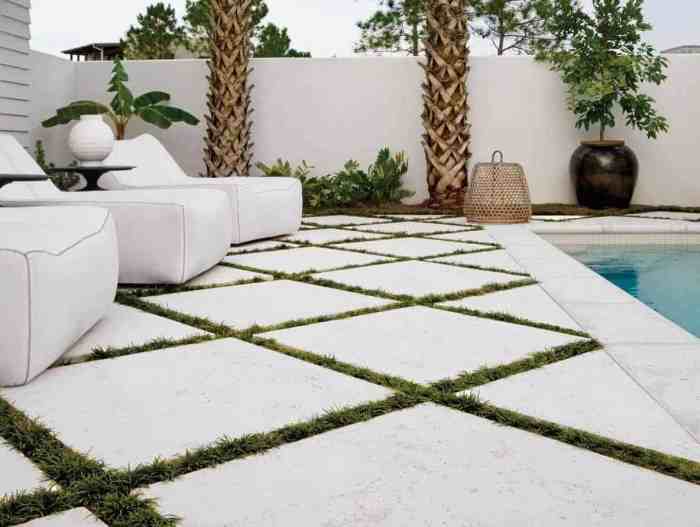
Geometric shapes and lines are essential elements in modern garden paving. They bring a sense of order and structure to the outdoor space, creating a visually appealing and functional area.Geometric shapes, such as squares, rectangles, circles, and triangles, can be used to create a variety of paving patterns.
These patterns can be simple or complex, depending on the desired effect. For example, a simple grid pattern can create a classic and timeless look, while a more complex pattern can add a touch of drama and interest.Lines can also be used to create a variety of effects in garden paving.
Straight lines can create a sense of order and direction, while curved lines can add a touch of softness and fluidity. Lines can also be used to define different areas of the garden, such as a seating area or a walkway.
Incorporating Geometric Shapes
There are many ways to incorporate geometric shapes into garden paving. One popular method is to use paving slabs or tiles that are cut into geometric shapes. These slabs can be laid in a variety of patterns to create different effects.
Another method is to use natural materials, such as pebbles or gravel, to create geometric shapes in the paving. This can be done by creating raised beds or by using different colors of materials to create patterns.
Natural Stone and Concrete
Natural stone and concrete are two popular materials used in modern garden paving. Both materials have their own unique advantages and disadvantages.Natural stone is a durable material that can last for many years. It is also available in a variety of colors and textures, which makes it a versatile option for any garden design.
However, natural stone can be expensive and difficult to install.Concrete is a more affordable option than natural stone. It is also easier to install and can be customized to create a variety of different looks. However, concrete is not as durable as natural stone and can crack or chip over time.
Combining Natural Stone and Concrete
Natural stone and concrete can be combined to create unique and visually appealing designs. For example, you could use natural stone for the main paving area and concrete for the borders. You could also use different colors and textures of natural stone to create a more interesting look.
Lighting and Illumination
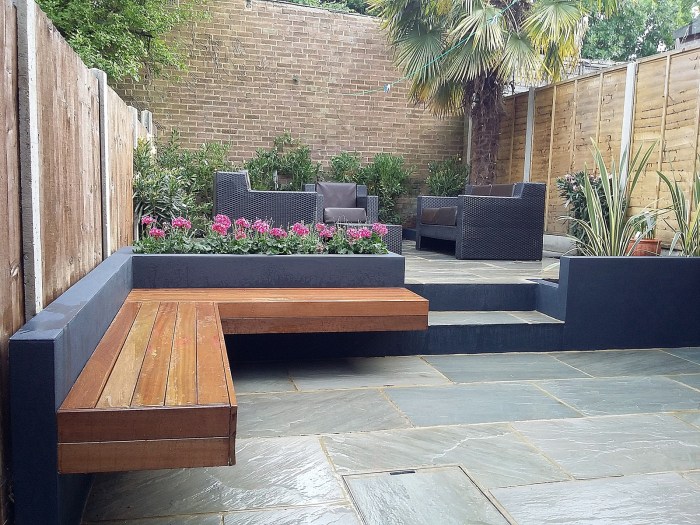
In modern garden paving, lighting plays a pivotal role in enhancing the aesthetic appeal and functionality of the space. It illuminates pathways, highlights architectural features, and creates a warm and inviting ambiance. By strategically incorporating lighting techniques, homeowners can transform their outdoor areas into captivating nighttime destinations.
Different lighting techniques can be employed to achieve various effects. Path lighting, for instance, provides safe and convenient navigation, while uplighting casts dramatic shadows on walls and trees. Spotlights can accentuate specific elements, such as sculptures or water features, while ambient lighting creates a soft, diffused glow that enhances the overall atmosphere.
Integrating Lighting into Paving Designs
Lighting can be seamlessly integrated into paving designs to create visually stunning effects. Inset lighting, where fixtures are embedded within the paving stones, emits a subtle glow that delineates pathways and adds a touch of elegance. Bollards, with their sleek and modern aesthetic, provide both illumination and architectural interest.
Step lighting, installed along the edges of steps, ensures safe navigation while adding a touch of drama to the landscape.
Sustainability and Environmental Considerations
When designing a modern garden, it’s crucial to consider the environmental impact of your choices. Sustainable paving materials minimize ecological damage and promote harmony with nature.Sustainable practices include using recycled or renewable materials, reducing waste, and minimizing water consumption during production.
Eco-friendly materials like permeable pavers allow water to infiltrate the ground, reducing runoff and promoting groundwater recharge. By incorporating sustainable principles into your garden paving design, you create a beautiful and eco-conscious outdoor space.
Recycled Materials
Recycled materials, such as reclaimed bricks, concrete, or glass, reduce waste and conserve natural resources. They offer a unique aesthetic while contributing to environmental sustainability.
Permeable Pavers
Permeable pavers allow water to seep through their surface, replenishing groundwater and reducing stormwater runoff. They are an excellent choice for driveways, patios, and walkways, as they prevent puddles and improve drainage.
DIY Paving Projects: Modern Garden Paving Ideas
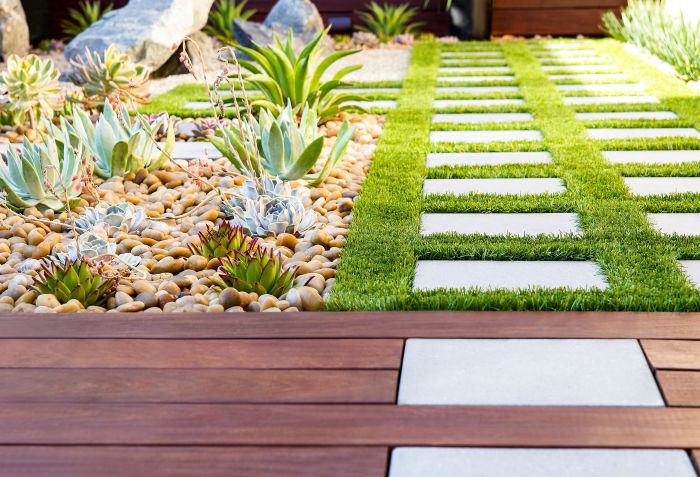
Embark on a rewarding DIY paving project to transform your outdoor space. With careful planning and execution, you can create a durable and visually appealing patio, walkway, or driveway.
Tools and Materials
Gather essential tools like a level, measuring tape, shovel, tamper, and trowel. Choose paving materials that suit your style and budget, such as concrete pavers, natural stone, or gravel.
Preparing the Base
Excavate the area to a depth of 4-6 inches, ensuring a level and compacted base. Install edging around the perimeter to contain the pavers and prevent shifting.
Laying the Pavers
Spread a layer of sand over the base and screed it to a uniform thickness. Place the pavers in a desired pattern, ensuring tight joints and a level surface. Use a rubber mallet to tap them into place.
Filling Joints
Apply jointing sand to the spaces between the pavers and sweep it into the gaps. Use a vibrating plate compactor to settle the sand and create a stable surface.
Finishing Touches
Clean the pavers with water and seal them to protect them from the elements. Add decorative elements like lighting or planters to enhance the overall aesthetic.
Cost Considerations
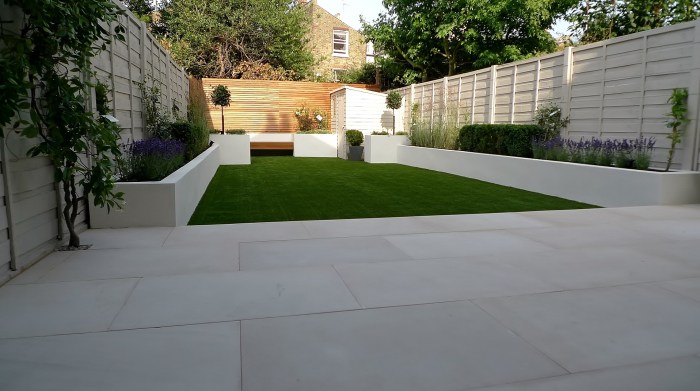
Paving your garden can be a significant investment, so it’s essential to consider the costs involved. The price of paving materials and installation methods can vary widely, and several factors can affect the overall cost of your project.
The type of paving material you choose is one of the most significant factors that will affect the cost of your project. Natural stone, such as granite or limestone, is more expensive than concrete or brick. However, it is also more durable and can last for many years.
Concrete and brick are less expensive than natural stone, but they are also less durable and may need to be replaced sooner.
The size and complexity of your paving project will also affect the cost. A small, simple patio will be less expensive to pave than a large, complex driveway. The cost of installation will also vary depending on the complexity of the project.
A simple installation will be less expensive than a complex installation that requires specialized equipment or techniques.
Tips for Saving Money on Paving
- Compare prices from multiple contractors before hiring one.
- Consider using less expensive paving materials, such as concrete or brick.
- Choose a simple paving design that will be less expensive to install.
- Do some of the work yourself, such as excavating the area or laying the pavers.
- Get creative and find ways to reuse or repurpose materials.
Maintenance and Care
Regular maintenance is crucial for the longevity and aesthetics of modern garden paving. Neglecting proper care can lead to premature deterioration, discoloration, and reduced lifespan.
Cleaning is essential to remove dirt, debris, and organic matter that can accumulate on the surface. Use a pressure washer with a low-pressure setting to avoid damaging the paving. For stubborn stains, apply a cleaning solution specifically designed for the type of paving material used.
Sealing the paving after cleaning helps protect it from stains, moisture penetration, and UV damage. Use a high-quality sealant that is compatible with the paving material.
Tips for Extending Lifespan, Modern garden paving ideas
- Avoid using harsh chemicals or abrasive cleaners.
- Sweep or hose down the paving regularly to remove loose dirt and debris.
- Repair any cracks or chips promptly to prevent further damage.
- Protect the paving from heavy furniture or equipment by using protective pads.
- Consider applying a protective coating to enhance durability and resistance to wear and tear.
Case Studies and Inspirations
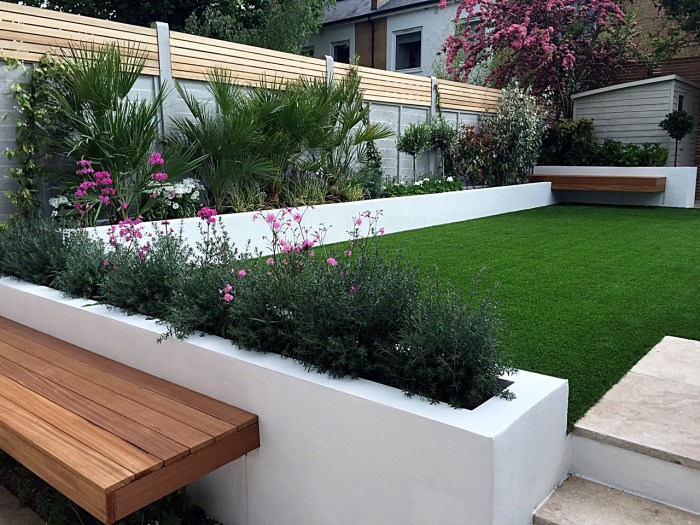
Modern garden paving designs come to life in these real-world examples, showcasing innovative concepts and materials.
From geometric patterns to natural stone elegance, these case studies offer a glimpse into the transformative power of modern paving.
Suburbia Sanctuary
This suburban garden transformed its outdoor space with a sleek and contemporary paving design.
Angular concrete pavers in varying shades of gray create a geometric pattern that leads the eye to a central seating area.
Natural stone accents add warmth and texture, while integrated lighting illuminates the path and creates a cozy ambiance.
Conclusion
As you navigate the realm of modern garden paving, let these ideas ignite your creativity and guide you towards a garden that is both visually stunning and practically perfect. Embrace the fusion of form and function, and let your outdoor space become a sanctuary where nature and design harmonize.
FAQ
What are the advantages of using natural stone for garden paving?
Natural stone offers durability, unique aesthetic appeal, and a timeless charm that complements any garden style.
How can I incorporate geometric shapes into my paving design?
Geometric shapes create a sense of order and structure. Use contrasting colors or materials to highlight specific areas or create visual interest.
What are some DIY paving projects suitable for beginners?
Consider creating a stepping stone path, a small patio area, or a border around a flower bed. These projects are relatively easy to execute and provide a sense of accomplishment.


